Metamitron Thinning Efficacy of Apple Fruitlets Is Affected by Different Rates, Timings and Weather Factors in New York State
Abstract
:1. Introduction
2. Materials and Methods
2.1. Plant Material and Experimental Design
2.2. Study Rate, Timings and Weather Conditions
2.3. Weather Conditions
2.4. Thinning Efficacy
2.5. Statistical Analysis
3. Results
3.1. Effect of Rate of Metamitron
3.2. Effect of Timing of Application
3.3. Effect of Weather Conditions
3.3.1. Solar Radiation
3.3.2. Minimum Temperatures
3.3.3. Maximum Temperatures (24 h)
4. Discussion
5. Conclusions
Author Contributions
Funding
Data Availability Statement
Acknowledgments
Conflicts of Interest
References
- Robinson, T.L.; Gonzalez, L.; Cheng, L.; Ziang, Y.; Peck, G.; Arnoldussen, B.; Gomez, M.; Guerra, M.; Miranda Sazo, M.; Kahlke, C.; et al. Studies in precision crop load management of apple. In Proceedings of the XXXI International Horticultural Congress (IHC2022): International Symposium on Innovative Perennial Crops Management, Angers, France, 14–20 August 2022; pp. 219–226. [Google Scholar] [CrossRef]
- Gonzalez, L.; Torres, E.; Àvila, G.; Bonany, J.; Alegre, S.; Carbó, J.; Martín, B.; Recasens, I.; Asin, L. Evaluation of chemical fruit thinning efficiency using Brevis® (Metamitron) on apple trees (‘Gala’) under Spanish conditions. Sci. Hortic. 2020, 261, 109003. [Google Scholar] [CrossRef]
- Gonzalez, L.; Torres, E.; Àvila, G.; Carbó, J.; Bonany, J.; Alegre, S.; Asin, L. Effect of thinning with metamitron, NAA, BA and naphthenic acids on apple (Malus domestica) trees. Plant Growth Regul. 2023. [Google Scholar] [CrossRef]
- Lordan, J.; Alins, G.; Àvila, G.; Torres, E.; Carbó, J.; Bonany, J.; Alegre, S. Screening of eco-friendly thinning agents and adjusting mechanical thinning on ‘Gala’, ‘Golden Delicious’ and ‘Fuji’ apple trees. Sci. Hortic. 2018, 239, 141–155. [Google Scholar] [CrossRef]
- Robinson, T.; Lakso, A. Between year and within year variation in chemical fruit thinning efficacy of apple during cool springs. Acta Hortic. 2004, 636, 283–294. [Google Scholar] [CrossRef]
- Byers, R.E. Flower and Fruit Thinning and Vegetative: Fruiting Balance; CABI Publishing: Wallingford, UK, 2003; pp. 409–436. [Google Scholar]
- Gonzalez, L.; Àvila, G.; Carbó, J.; Bonany, J.; Alegre, S.; Torres, E.; Martin, B.; Recasens, I.; Asin, L. Hail nets do not affect the efficacy of metamitron for chemical thinning of apple trees. J. Hortic. Sci. Biotechnol. 2020, 95, 128–135. [Google Scholar] [CrossRef]
- Gonzalez, L.; Torres, E.; Carbó, J.; Alegre, S.; Bonany, J.; Àvila, G.; Martin, B.; Recasens, I.; Asin, L. Effect of different application rates of metamitron as fruitlet chemical thinner on thinning efficacy and fluorescence inhibition in Gala and Fuji apple. Plant Growth Regul. 2019, 89, 259–271. [Google Scholar] [CrossRef]
- Lafer, G. Effects of Chemical Thinning with Metamitron on Fruit Set, Yield and Fruit Quality of ‘Elstar’. In XI International Symposium on Plant Bioregulators in Fruit Production 884; Costa, G., Ed.; Acta Horticulturae; International Society Horticultural Science: Leuven, Belgium, 2010; Volume 884, pp. 531–536. [Google Scholar]
- Basak, A. Efficiency of fruitlet thinning in apple “Gala Must” by use of metamitron and artificial shading. J. Fruit Ornam. Plant Res. 2011, 19, 51–62. [Google Scholar]
- McArtney, S.J.; Obermiller, J.D.; Arellano, C. Comparison of the Effects of Metamitron on Chlorophyll Fluorescence and Fruit Set in Apple and Peach. Hortscience 2012, 47, 509–514. [Google Scholar] [CrossRef]
- ADAMA. Over 600 Trials Globally Back Innovative New Apple Thinner Brevis®; New Zealand. 2017. Available online: https://www.adama.com/new-zealand/en/news-and-media/adama/over-600-trials-globally-back-innovative-new-apple-thinner-brevis (accessed on 24 February 2022).
- Mathieu, V.; Lavoisier, C.; Bouniol, M.; Saint Hilary, J.F. Apple thinning by photosynthesis inhibition. In Eufrin Thinning Working Group Symposia; Costa, G., Ed.; Acta Horticulturae; International Society Horticultural Science: Leuven, Belgium, 2016; Volume 1138, pp. 19–26. [Google Scholar]
- Petri, J.L.; Couto, M.; Gabardo, G.C.; Francescatto, P.; Hawerroth, F.J. Metamitron replacing carbaryl in post bloom thinning of apple trees. Rev. Bras. Frutic. 2016, 38, 14. [Google Scholar] [CrossRef]
- Greene, D.W. Use of Metamitron Alone and in Combination with 6-Benzyladenine for Thinning Apples. In XII International Symposium on Plant Bioregulators in Fruit Production; McArtney, S.J., Spann, T., Eds.; Acta Horticulturae; International Society Horticultural Science: Leuven, Belgium, 2014; Volume 1042, pp. 167–172. [Google Scholar]
- McArtney, S.J.; Obermiller, J.D. Use of 1-Aminocyclopropane Carboxylic Acid and Metamitron for Delayed Thinning of Apple Fruit. Hortscience 2012, 47, 1612–1616. [Google Scholar] [CrossRef]
- Gonzalez, L.; Bonany, J.; Alegre, S.; Àvila, G.; Carbó, J.; Torres, E.; Recasens, I.; Martin, B.; Asin, L. Brevis thinning efficacy at different fruit size and fluorescence on ‘Gala’ and ‘Fuji’ apples. Sci. Hortic. 2019, 256, 108526. [Google Scholar] [CrossRef]
- Gonzalez, L.; Francescatto, P.; Lordan, J.; Robinson, T.L. Rate and timing of metamitron affect thinning efficacy of ‘Gala’ apple trees under American northeast conditions. In Proceedings of the XIV International Symposium on Plant Bioregulators in Fruit Production, Virtual Meeting; 2022. Acta Horticulturae 1344. pp. 55–64. [Google Scholar]
- Rosa, N. Comparison between Benzyladenine and Metamitron as Chemical Thinning Agents in Gala, Kanzi, Pink Lady and Red Delicious Apple Cultivars. Ph.D. Thesis, Universidade de Lisboa, Lisboa, Portugal, 2016. [Google Scholar]
- Iwanami, H.; Moriya-Tanaka, Y.; Honda, C.; Wada, M.; Moriya, S.; Okada, K.; Haji, T.; Abe, K. Relationships among apple fruit abscission, source strength, and cultivar. Sci. Hortic. 2012, 146, 39–44. [Google Scholar] [CrossRef]
- Lakso, A.N.; Robinson, T.L.; Greene, D.W. Integration of environment, physiology and fruit abscission via carbon balance modeling—Implications for understanding growth regulator responses. In X International Symposium on Plant Bioregulators in Fruit Production; Acta Horticulturae 727; International Society for Horticultural Science: Leuven, Belgium, 2006; pp. 321–326. [Google Scholar]
- Agnello, A. 2017 Cornell Pest Management Guidelines for Commercial Tree Fruit Production; Cornell University Cooperative Extension: Ithaca, NY, USA, 2017; Available online: https://cropandpestguides.cce.cornell.edu/Preview/Tree_Fruit_Sample_Promo.pdf (accessed on 24 February 2022).
- Gonzalez Nieto, L.; Wallis, A.; Clements, J.; Miranda Sazo, M.; Kahlke, C.; Kon, T.M.; Robinson, T.L. Evaluation of Computer Vision Systems and Applications to Estimate Trunk Cross-Sectional Area, Flower Cluster Number, Thinning Efficacy and Yield of Apple. Horticulturae 2023, 9, 880. [Google Scholar] [CrossRef]
- Byers, R.E.; Barden, J.A.; Polomski, R.F.; Young, R.W.; Carbaugh, D.H. Apple Thinning by Photosynthetic Inhibition. J. Am. Soc. Hortic. Sci. 1990, 115, 14–19. [Google Scholar] [CrossRef]
- Brunner, P. Impact of Metamitron as a Thinning Compound on Apple Plants. In XII International Symposium on Plant Bioregulators in Fruit Production 1042; McArtney, S.J., Spann, T., Eds.; Acta Horticulturae; International Society Horticultural Science: Leuven, Belgium, 2014; Volume 1042, pp. 173–181. [Google Scholar]
- Deckers, T.; Schoofs, H.; Verjans, W. Looking for Solutions for Chemical Fruit Thinning on Apple. In XI International Symposium on Plant Bioregulators in Fruit Production 884; Costa, G., Ed.; Acta Horticulturae; International Society Horticultural Science: Leuven, Belgium, 2010; Volume 884, pp. 237–244. [Google Scholar]
- Cline, J.A.; Bakker, C.J.; Beneff, A. Multi-year investigation on the rate, timing, and use of surfactant for thinning apples with post-bloom applications of metamitron. Can. J. Plant Sci. 2022, 102, 628–655. [Google Scholar] [CrossRef]
- Penzel, M.; Kröling, C. Thinning efficacy of metamitron on young ‘RoHo 3615’ (Evelina®) apple. Sci. Hortic. 2020, 272, 109586. [Google Scholar] [CrossRef]
- Reginato, G.; Riquelme, C.; Robinson, T.L. Evaluation of timing for spraying Metamitron or NAA plus BA for thinning ‘Brookfield Gala’ apple fruitlets. In International Symposium on Physiological Principles and Their Application to Fruit Production; Acta Horticulturae 1177; International Society for Horticultural Science: Leuven, Belgium, 2017; pp. 229–234. [Google Scholar]
- Reginato, G.; Osorio, H.; Navarrete, J. A Single Metamitron Spray Thinned ‘Brookfield Gala’ Apples as Effectively as a Program of Treatments Based on NAA, Carbaryl and BA. In X International Symposium on Integrating Canopy, Rootstock and Environmental Physiology in Orchard Systems 1058; Theron, K., Ed.; Acta Horticulturae; International Society Horticultural Science: Leuven, Belgium, 2014; Volume 1058, pp. 397–404. [Google Scholar]
- Greene, D.; Costa, G. Fruit thinning in pome-and stone-fruit: State of the art. In EUFRIN Thinning Working Group Symposia; Acta Horticulturae 998; International Society for Horticultural Science: Leuven, Belgium, 2013; pp. 93–102. [Google Scholar]
- Byers, R.E.; Lyons, C.G.; Yoder, K.S.; Barden, J.A.; Young, R.W. Peach and apple thinning by shading and photosynthetic inhibition. J. Hortic. Sci. 1985, 60, 465–472. [Google Scholar] [CrossRef]
- Grappadelli, L.C.; Lakso, A.N.; Flore, J.A. Early season patterns of carbohydrate partitioning in exposed and shaded apple branches. J. Am. Soc. Hortic. Sci. 1994, 119, 596–603. [Google Scholar] [CrossRef]
- Greene, D.W.; Groome, P. Effect of Thinner and Time of Shading on Fruit Set of ‘McIntosh’ Apples. In XI International Symposium on Plant Bioregulators in Fruit Production 884; Costa, G., Ed.; Acta Horticulturae; International Society Horticultural Science: Leuven, Belgium, 2010; Volume 884, pp. 505–510. [Google Scholar]
- Robinson, T.L.; Lakso, A.N.; Greene, D.; Reginato, G.; Rufato, A.D. Managing fruit abscission in apple part 1. In XXIX International Horticultural Congress on Horticulture: Sustaining Lives, Livelihoods and Landscapes (IHC2014): 1119; Wunsche, J.N., Tranbarger, T.J., Eds.; Acta Horticulturae; International Society Horticultural Science: Leuven, Belgium, 2016; Volume 1119, pp. 1–13. [Google Scholar]
- Lakso, A.N. Early Fruit Growth and Drop—The Role of Carbon Balance in the Apple Tree. In IX International Symposium on Integrating Canopy, Rootstock and Environmental Physiology in Orchard Systems 903; Robinson, T.L., Ed.; Acta Horticulturae; International Society Horticultural Science: Leuven, Belgium, 2011; Volume 903, pp. 733–742. [Google Scholar]
- Rosa, N.D.H. A Comprehensive Study of the Effect of Meteorological Conditions on Fruit Abscission and Metamitron Thinning Efficacy in Malus Domestica Borkh. Ph.D. Thesis, Universidade de Lisboa, Lisboa, Portugal, 2017. [Google Scholar]
- Clever, M. Effects of solar irradiation and night-time temperature on the thinning efficacy of metamitron (Brevis®) in apple. In EUFRIN Thinning Working Group Symposia 1221; Acta Horticulturae; International Society for Horticultural Science: Leuven, Belgium, 2018; Volume 1221, pp. 23–30. [Google Scholar] [CrossRef]
- Parra-Quezada, R.; Robinson, T.; Osborne, J.; Lakso, A.; Parra-Bujanda, L. Temperature and chemical thinner affect fruit set, and growth of Empire apple. In X International Symposium on Plant Bioregulators in Fruit Production; Acta Horticulturae 727; International Society for Horticultural Science: Leuven, Belgium, 2005; pp. 327–336. [Google Scholar]
- Kviklys, D.; Robinson, T. Temperature before and after Application of Chemical Thinners Affects Thinning Response of ‘Empire’ Apple Trees. In XI International Symposium on Plant Bioregulators in Fruit Production 884; Costa, G., Ed.; Acta Horticulturae; International Society Horticultural Science: Leuven, Belgium, 2010; Volume 884, pp. 525–530. [Google Scholar]
- Li, P.; Cheng, L. Varietal Difference of Apple Peel in Response to High Temperature and High Light Stress as Evaluated by Chlorophyll Fluorescence. In IX International Symposium on Integrating Canopy, Rootstock and Environmental Physiology in Orchard Systems 903; Robinson, T.L., Ed.; Acta Horticulturae; International Society Horticultural Science: Leuven, Belgium, 2011; Volume 903, pp. 1049–1054. [Google Scholar]
- Pretorius, J.J.B.; Theron, K.I.; Midgley, S.J.E. The Effect of Temperature and Developmental Stage on Carbon Dioxide Exchange of Attached ‘Royal Gala’, ‘Fuji’ and ‘Cripps’ Pink’ Apple Fruits. In IX International Symposium on Integrating Canopy, Rootstock and Environmental Physiology in Orchard Systems 903; Robinson, T.L., Ed.; Acta Horticulturae; International Society Horticultural Science: Leuven, Belgium, 2011; Volume 903, pp. 1077–1084. [Google Scholar]
- Lordan, J.; Reginato, G.H.; Lakso, A.N.; Francescatto, P.; Robinson, T.L. Natural fruitlet abscission as related to apple tree carbon balance estimated with the MaluSim model. Sci. Hortic. 2019, 247, 296–309. [Google Scholar] [CrossRef]
- Robinson, T.L.; Lakso, A.N. Advances in Predicting Chemical Thinner Response of Apple Using a Carbon Balance Model. NYS Fruit Ind. NYS Gov. 2011, 518, 15. [Google Scholar] [CrossRef]
- Jing, P.; Wang, D.; Zhu, C.; Chen, J. Plant Physiological, Morphological and Yield-Related Responses to Night Temperature Changes across Different Species and Plant Functional Types. Front. Plant Sci. 2016, 7, 1774. [Google Scholar] [CrossRef] [PubMed]
- Radivojevic, D.; Milivojevic, J.; Pavlovic, M.; Stopar, M. Comparison of metamitron efficiency for postbloom thinning of young ‘Gala’and ‘Golden Delicious’ apple trees. Turk. J. Agric. For. 2019, 43, 83–94. [Google Scholar] [CrossRef]
- Greer, D.H. Temperature-dependent responses of the photosynthetic and chlorophyll fluorescence attributes of apple (Malus domestica) leaves during a sustained high temperature event. Plant Physiol. Biochem. 2015, 97, 139–146. [Google Scholar] [CrossRef] [PubMed]
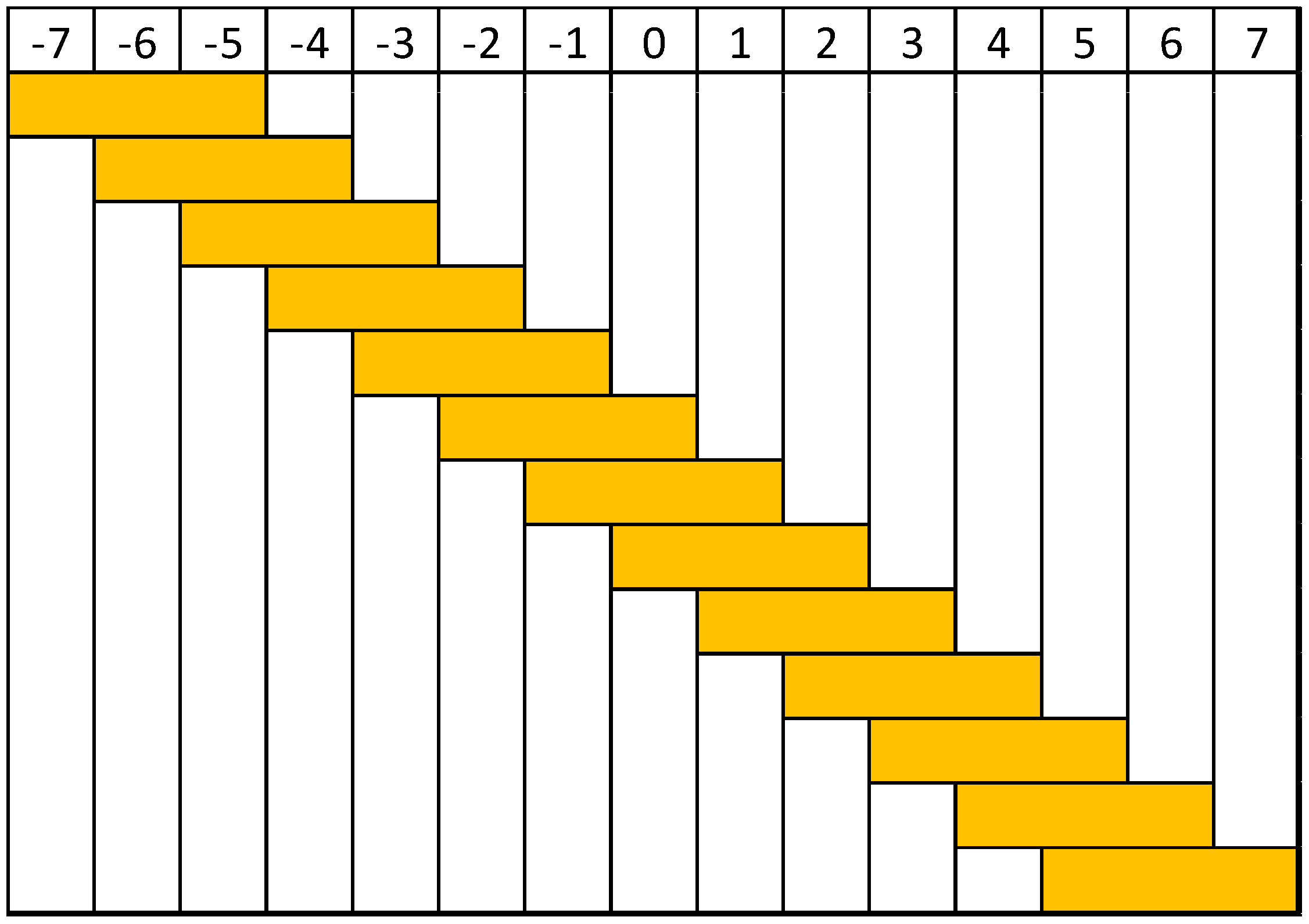
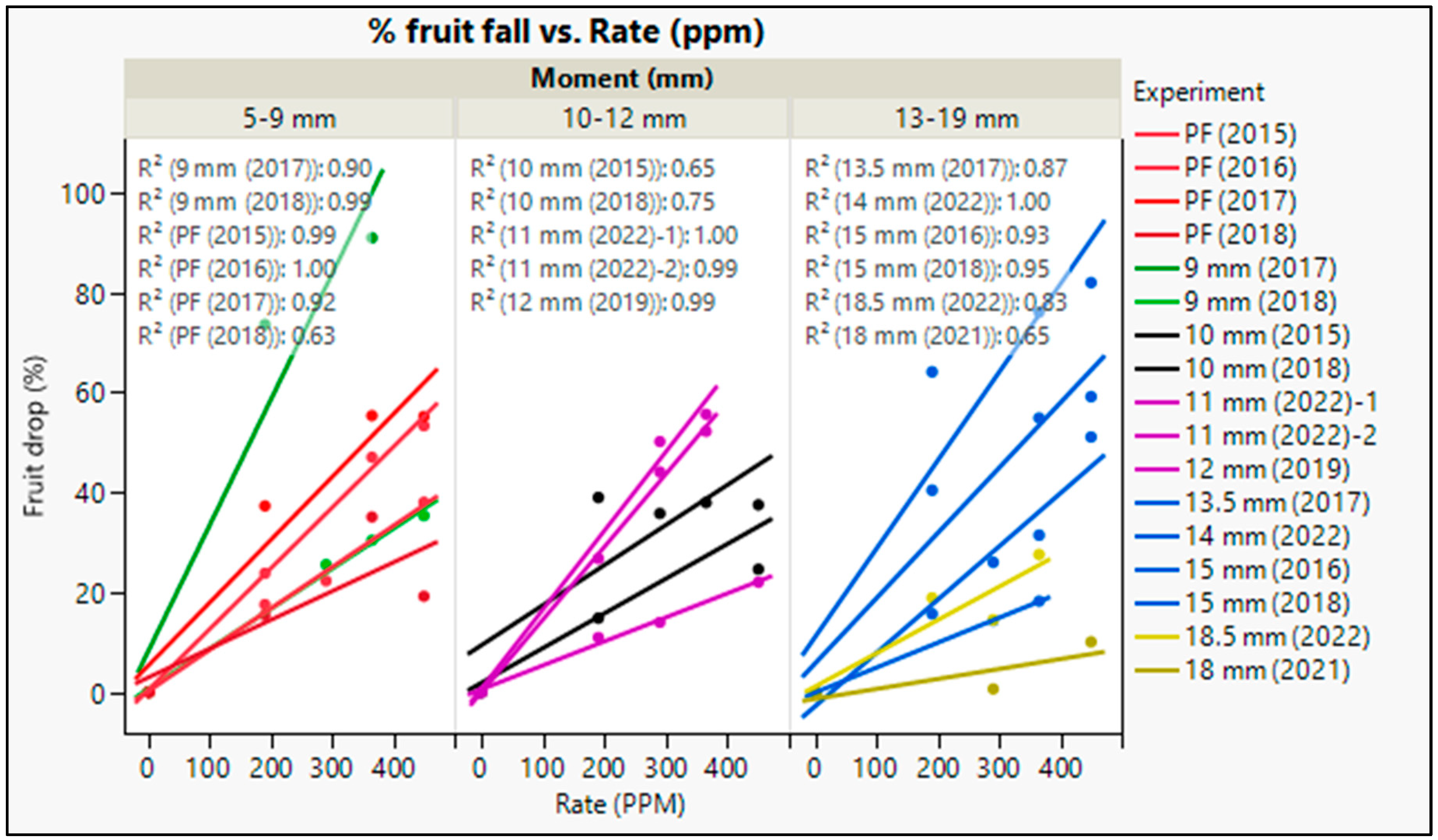

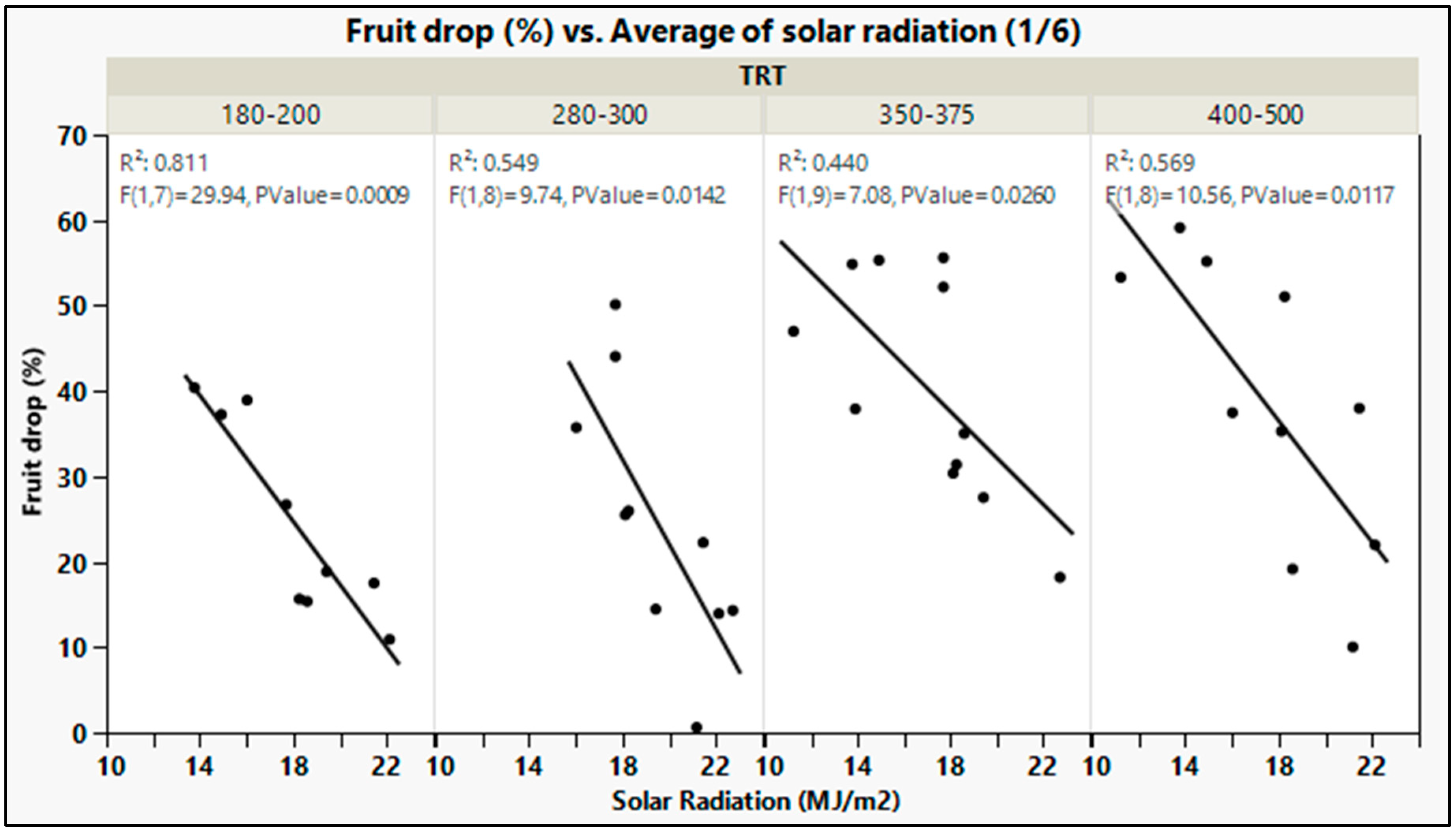
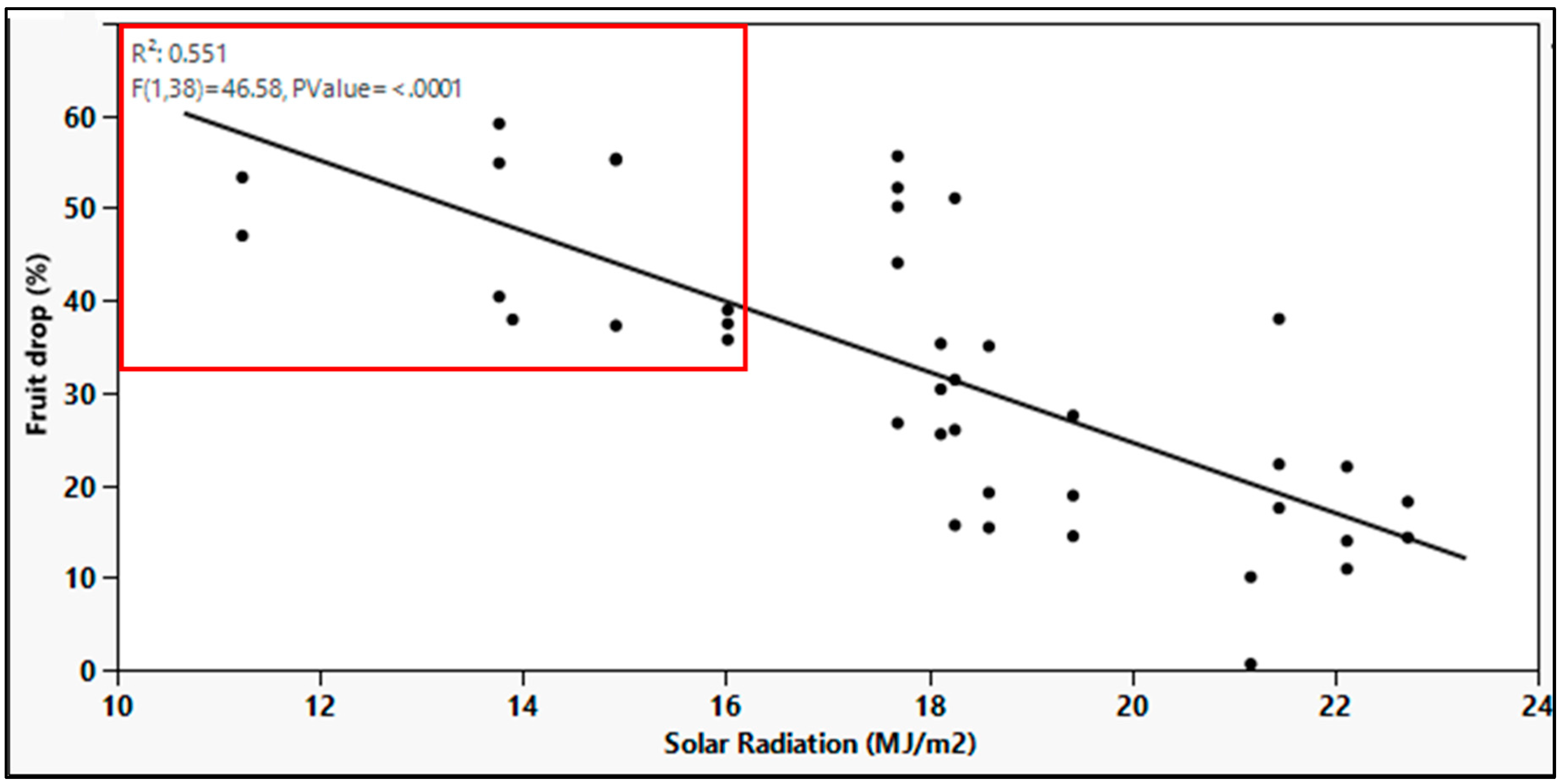
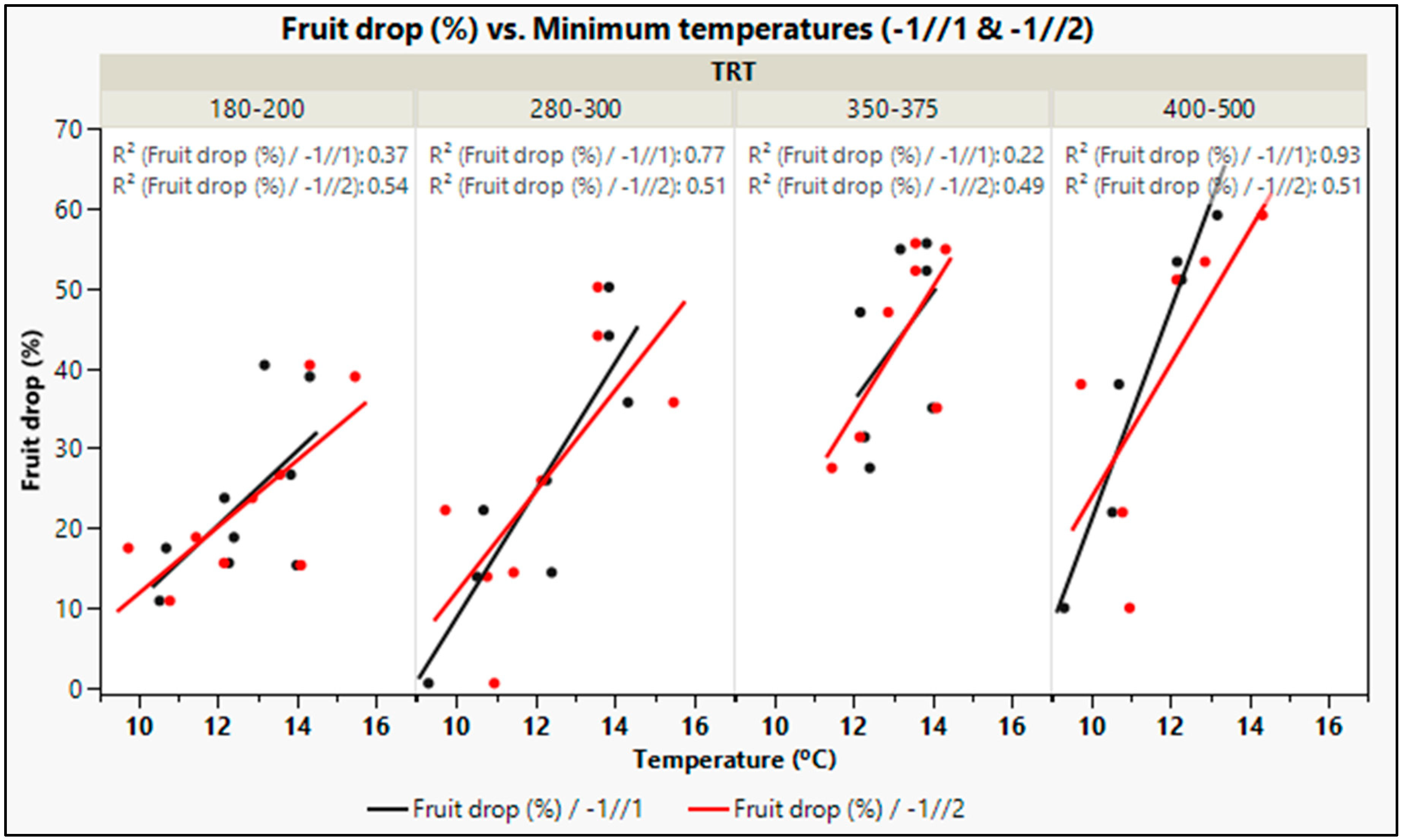
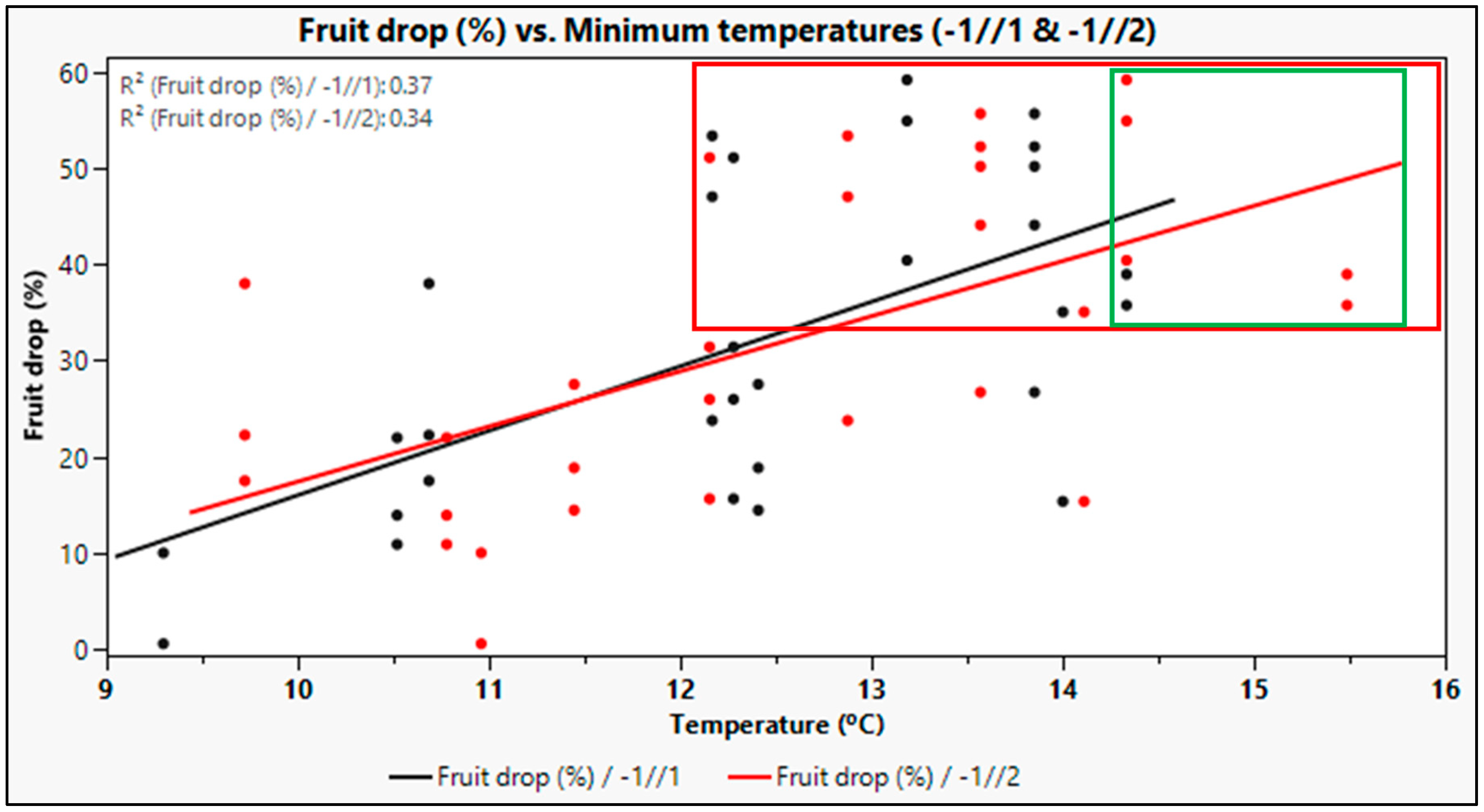

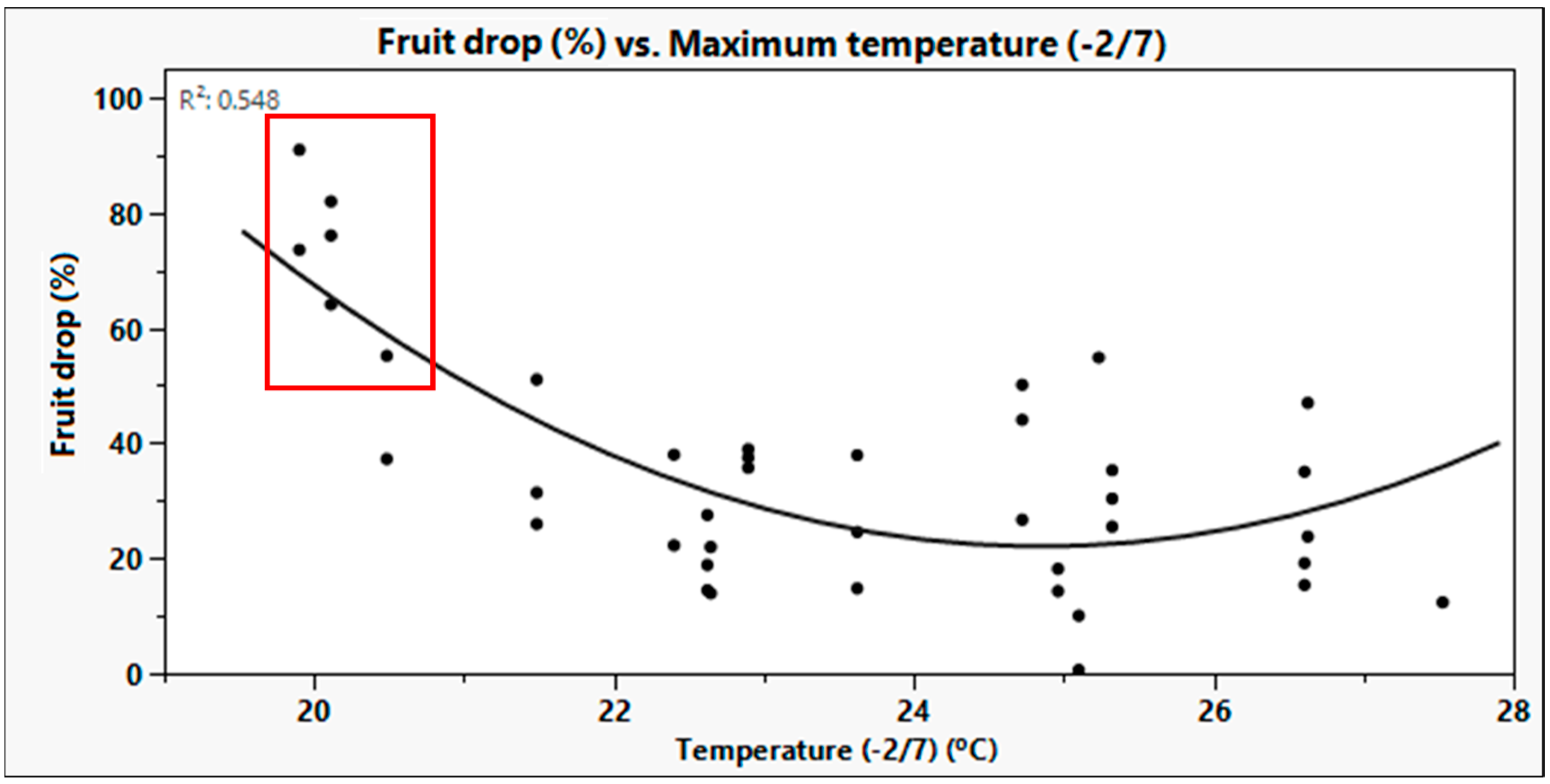
| Year | Timing (mm) | Rate (ppm) | ||||
|---|---|---|---|---|---|---|
| 0 | 180–200 | 280–300 | 350–375 | 400–500 | ||
| 2015 | Petal Fall (4.5 mm) | X | X | X | X | |
| 10 mm | X | X | X | X | ||
| 2016 | Petal Fall (4.5 mm) | X | X | X | X | |
| 15 mm | X | X | X | X | ||
| 2017 | Petal Fall (4.5 mm) | X | X | X | X | |
| 9 mm | X | X | X | |||
| 13.5 mm | X | X | X | X | ||
| 2018 | Petal Fall (4.5 mm) | X | X | X | X | |
| 9 mm | X | X | X | X | ||
| 10 mm | X | X | X | X | ||
| 15 mm | X | X | X | X | X | |
| 2019 | 12 mm | X | X | X | X | |
| 2021 | 18 mm | X | X | X | ||
| 2022 | 11 mm (1) | X | X | X | X | |
| 11 mm (2) | X | X | X | |||
| 14 mm | X | X | X | |||
| 18.5 mm | X | X | X | X | ||
| Weather Data Evaluated | Period |
|---|---|
| Solar radiation (MJ/m2) | 08:00 to 20:00 |
| Daytime temperature (°C) | 08:00 to 20:00 |
| Maximum temperature (°C) | 00:00–24:00 |
| 24 h temperature (°C) | 00:00–24:00 |
| Minimum temperature (°C) | 00:00–24:00 |
| Night-time temperature (°C) | 21:00 h up to 7:00 of the next day |
Disclaimer/Publisher’s Note: The statements, opinions and data contained in all publications are solely those of the individual author(s) and contributor(s) and not of MDPI and/or the editor(s). MDPI and/or the editor(s) disclaim responsibility for any injury to people or property resulting from any ideas, methods, instructions or products referred to in the content. |
© 2023 by the authors. Licensee MDPI, Basel, Switzerland. This article is an open access article distributed under the terms and conditions of the Creative Commons Attribution (CC BY) license (https://creativecommons.org/licenses/by/4.0/).
Share and Cite
Gonzalez Nieto, L.; Francescatto, P.; Carra, B.; Robinson, T.L. Metamitron Thinning Efficacy of Apple Fruitlets Is Affected by Different Rates, Timings and Weather Factors in New York State. Horticulturae 2023, 9, 1179. https://doi.org/10.3390/horticulturae9111179
Gonzalez Nieto L, Francescatto P, Carra B, Robinson TL. Metamitron Thinning Efficacy of Apple Fruitlets Is Affected by Different Rates, Timings and Weather Factors in New York State. Horticulturae. 2023; 9(11):1179. https://doi.org/10.3390/horticulturae9111179
Chicago/Turabian StyleGonzalez Nieto, Luis, Poliana Francescatto, Bruno Carra, and Terence Lee Robinson. 2023. "Metamitron Thinning Efficacy of Apple Fruitlets Is Affected by Different Rates, Timings and Weather Factors in New York State" Horticulturae 9, no. 11: 1179. https://doi.org/10.3390/horticulturae9111179
APA StyleGonzalez Nieto, L., Francescatto, P., Carra, B., & Robinson, T. L. (2023). Metamitron Thinning Efficacy of Apple Fruitlets Is Affected by Different Rates, Timings and Weather Factors in New York State. Horticulturae, 9(11), 1179. https://doi.org/10.3390/horticulturae9111179








